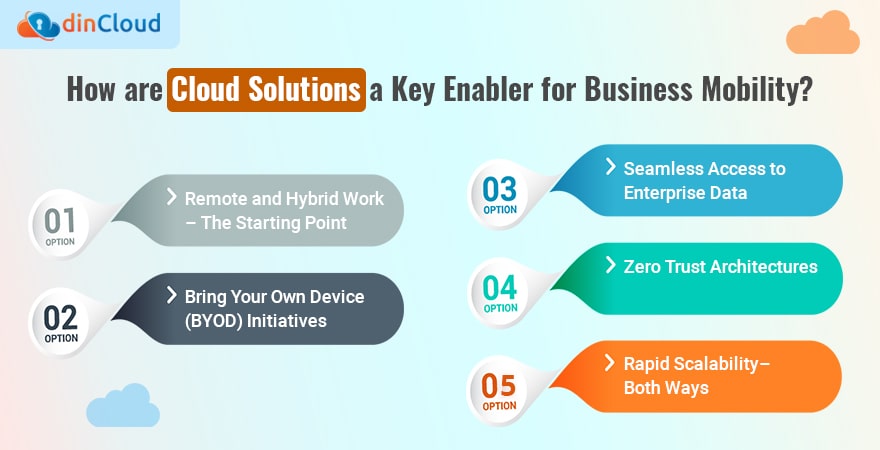In the business world, the word business mobility can have a lot of dimensions. In fact, every business would have its unique perspective on what constitutes business mobility for that particular industry or niche.
However, when we view business mobility in the context of digital technologies, it is rapidly becoming a key enabler for sustainable business models. Over the past two years or so, digitalization has become the main vehicle for enhancing business mobility.

Remote and Hybrid Work – The Starting Point
If the global pandemic has proven one thing, it is that enterprise and employee productivity are no longer linked just to the physical boundaries of the workplace. In fact, the workplace has gradually morphed into a virtual setting, where employees connect digitally.
While this may not be the case for every industry or business model out there, digitally powered enterprise solutions like Cloud Hosted Virtual Desktops have proved a lifesaver for thousands of businesses across the globe.
Related: The Difference Between a Virtual Private Server and Dedicated Server
So, when we talk of business mobility from a digitalization standpoint, delivering secure, reliable and capable remote work solutions to the workforce is key. In the near future, we can expect the workplace to take the shape of hybrid work models.
Regardless of whether it is a full-on remote work setting, or hybrid work models, cloud powered productivity solutions will be indispensable. It is solutions like dinCloud Hosted Virtual Desktops (dinHVD) that fill this void, and deliver remarkable business mobility.
Related: Healthcare Providers Attain Hyper Innovation with Rapid Digitalization
Bring Your Own Device (BYOD) Initiatives
This is yet another area which is proving mutually beneficial for both enterprises and the workforce alike. However, data governance, cyber security, privacy and regulatory compliance impose certain limitations on traditional BYOD initiatives.
With cloud computing solutions though, enterprises can now implement BYOD initiatives with both confidence, and a sense of security. From an IT hardware perspective, this means investing less in the procurement and maintenance of physical employee devices.
Remotely working employees on the other hand, don’t feel the difference that much. This is because in the case of cloud solutions for enterprise productivity, no sensitive data actually resides on the individual devices under the use of remotely working employees.
Related: How are the Cloud, Edge and AI Helping to Fight Fires?
Seamless Access to Enterprise Data
In most remote work environments, enterprises struggle to give their remote employees seamless access to enterprise data. This not only raises security concerns, but may also impose productivity related limitations when employees can’t access data on time.
With solutions like Cloud Hosted Virtual Desktops, Servers and Databases though, remote employees have seamless access to both enterprise data and productivity solutions hosted within the secure cloud infrastructure of the Cloud Service Provider (CSP) like dinCloud.
Zero Trust Architectures
As enterprises transition towards mid to long term remote or hybrid work scenarios, data security challenges become much more pronounced. With cloud solutions however, it becomes both possible and cost effective for enterprises to go for Zero Trust Security.
Zero Trust Architectures (ZTA) negate the notions of perpetual and un-conditional trust, by passing remote employees through proper authentication protocols. Take the example of leading cloud provider dinCloud, which offers robust Two Factor Authentication (2FA).
With centrally housed data in the case of cloud solutions, enterprises are in a much better position to protect their digital assets against unauthorized or un-necessary access. This is achieved by micro segmentation of the data in the Cloud, based on key functional areas.
Related: How Should Businesses Gear-Up for Hyper Innovation?
Rapid Scalability – Both Ways
Cloud solutions give a whole new meaning to business mobility due to their capability of rapid scaling. Unlike on-premise IT infrastructures which need additional hardware to cater to demand spikes, cloud solutions can scale rapidly with no such requirement.
The same holds true for scaling down, as you can scale down without worrying about any un-utilized on-premise IT hardware resources. The Cloud offers scalability that is independent of the physical location of the workplace.
By leveraging the Cloud, you can on-board a new employee who could be located on a completely different continent. All you have to do is grant access to a cloud desktop and the productivity solutions that are hosted over the Cloud , and the ball starts rolling.
Related: CloudOps – A Rundown of Cloud Operations and Management
Conclusion
The post pandemic world has transformed the traditional approaches of business mobility. In order to fast track digitalization and attain meaningful business mobility, enterprises will have to embrace the cloud revolution.
If you are an enterprise that is looking to take its business mobility to a whole new level, look no further than dinCloud, a leading provider of secure, reliable and cost efficient cloud solutions.


